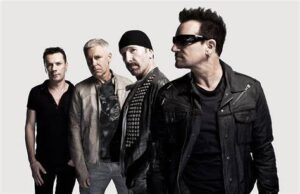
Groundbreaking album
The Joshua Tree by U2
The Joshua Tree focused on U2’s interest in America’s foreign policies and the American ideals of freedom and democracy. The music had a sense of location and the lyrics drew on the imagery created by American authors. The lyrics for all of the tracks were written by Bono and the music was written collectively by U2. The Joshua Tree opened with “Where the Streets Have No Name,” then “I Still Haven’t Found What I’m Looking For,” “With or Without You,” “Bullet the Blue Sky,” “Running to Stand Still,” “Red Hill Mining Town,” “In God’s Country,” “Trip Through Your Wires,” “One Tree Hill,” “Exit,” and “Mothers of the Disappeared.”
“I Still Haven’t Found What I’m Looking For” (much like the whole record) was inspired by U2’s fascination with America and American music. In this song, the band drew from gospel music and choir-influenced backing vocals sung by Edge and producers Brian Eno and Daniel Lanois. A music video for the song was filmed in Las Vegas, Nevada. It showed Edge on Fremont Street playing an acoustic guitar while the other band members were wandering around the street.
“With or Without You” is a dark love song that reflected Bono’s conflicted feelings about his life as a musician and that of being an ordinary man. Edge created a unique sound utilizing the Infinite Guitar. Edge allowed a single note to sustain indefinitely while other individual notes were treated to create new sounds. Edge commented on how U2 approached music as a band when he said, “The band is a family. Everyone looks after everyone else and no individual ego is bared to the public. There’s a band ego, there’s a band ambition. There’s a band arrogance as well, sometimes. And there’s also a belief that contemporary music can be more than just a soundtrack. It can be worthwhile and lasting, with a timeless quality when it’s really working. It should transcend any barriers of time or location, so anyone can find something in it, so that it doesn’t exclude people by being too fixed in its context.”
U2 continued to utilize the great musicianship, production skills, and overall musical vision of Brian Eno (see chapter eighteen) and Daniel Lanois from their previous work on The Unforgettable Fire album. On The Joshua Tree, Eno played keyboards, DX7 programming, and backing vocals while Lanois added an Omnichord (an electronic instrument with preset rhythms), rhythm guitar, tambourine, and backing vocals. Drummer Larry Mullen Jr. really felt that Lanois, in particular, took great interest in the rhythmic aspects of the songs. “Where the Streets Have No Name” and “In God’s Country,” conveyed a deep-seated yearning felt through Edge’s screaming guitar.